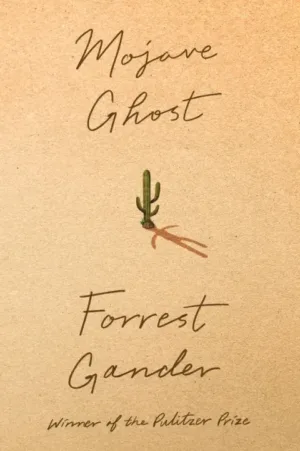Mojave Ghost
by Forrest Gander
reviewed by William Doreski
Forrest Gander calls Mojave Ghost a “novel-poem,” but it’s far more poem than novel. It is an extended elegy for C. D. Wright, his late wife. It also memorializes his mother, who died in the COVID pandemic, and himself. It is what Keats called a greeting of the spirit, a heartsore but empathic act of touching and reclaiming lost others. In the preface, Gander writes that a series of walks along the San Andreas fault occasioned his book. Mingling self-awareness with a sense of geography and history—natural history, especially geology, as well as social and personal history—his perambulating voice is critical as well as elegiac:
Now the Joshua trees are withering
in the drought—“not to recover
in our lifetimes”—and the desert below them
is spalling, unstitching itself. Now
itself is spalling incrementally
making itself unavailable to us.
Mojave Ghost offers a fractured narrative and a lyric sensibility, wielding a complex poetics familiar to readers of Gander’s previous work. This kaleidoscopic collection, by juxtaposing discrete images and bringing out the unexpected relations, startles the reader with imaginative perceptions: “After years of amputations, the sycamore limbs / by the courthouse end in huge, mangled fists.” They scramble the ordinary world just enough to force us to refresh our senses. These are common tactics in modern poetry, but Gander handles them uncommonly well. The imagery often has a scientific precision and his sense of the line is as strong as any poet’s since Ezra Pound. His ability to mingle abstract and concrete notions to link the world of the mind with the world of deserts and Gila monsters would please Wallace Stevens.
The figures addressed in this poem (or sequence of poems) shade off into each other. Their development as characters seems to have happened in the past, and their presence is ghostly, as the book’s title insists, even in the sections that apparently invoke Ashwini Bhat, who accompanied Gander on his long walks. These sections, although written in the present tense, seem almost as historical as the passages that address Gander’s late wife and mother. The narrator believes he has become disconnected: “I see the lives of others. But not their actual lives.” In one sense, this is a commonplace: we cannot see the lives people live inside themselves. And we can’t enter the mysterious being of ghosts—we can only remember and address them as they were in life. On the other hand, it suggests how his focus on history has erected a half-imagined but dislocating structure between himself and others. A pervasive theme of this book is the narrator’s inability to embrace the full history of others, whether the ghosts of his past or the slightly hallucinatory but living friend before him.
Poetry, as practiced in the twentieth and twenty-first centuries, distances while intriguing us with its complex rhetorical strategies. Even in mingling genres, Gander can’t reject those strategies, since they are integral to him. So he strings an indistinct narrative through these poems and invites the reader to fill in the gaps. But novels usually avoid narrative gaps. The novel’s momentum requires a strong narrative and usually a plot. But although unplotted, Gander’s poem does delineate a journey, which is a form of narrative. As Ammons taught us, the poem is a walk. Or a series of walks. And these walks take Gander somewhere. By the end of the book, in the elegant “Coda,” he refreshes his perceptions of world around him and approaches a better sense of being, one that isn’t just in but is part of that world:
And so find myself in a shell
jacket and approach-shoes
strolling past boulders
on the xeric canyon path
limned with mustard flowers
as though it were my garden,
as though I’d never
drawn those distinctions
that separate me out,
as though I hadn’t long back
expelled myself from all that.
This passage almost resolves his elegiac mood. The ease of “strolling,” the mustard thriving despite the dry soil, and the garden as renewal suggest, despite his anxieties, a willingness to accept “a new point of view.”
Besides numerous collections of poems and poetic sequences, Forrest Gander has published an actual novel, As a Friend (2008), which displays a clear grasp of conventional narrative techniques, few of which he uses here. Mojave Ghosts may not be a novel, but it tells a story in the way that The Bridge, The Waste Land, and The Dolphin tell stories—through sequences of closely linked lyric or meditative poems. Regardless of genre-labels, this is a melancholic and compelling book, fraught with its own necessity.
Published on October 15, 2024

